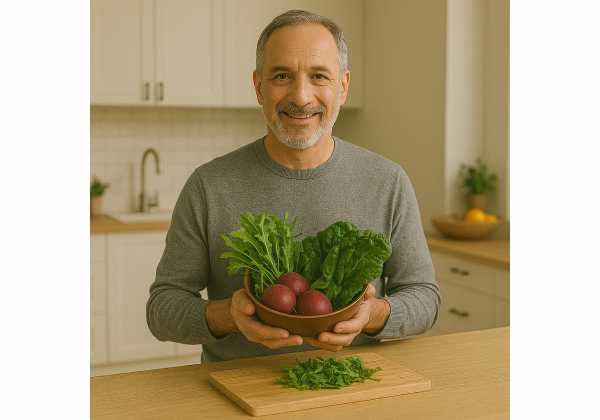
Dietary nitrates from vegetables do quiet work with big payoffs. Through the nitrate–nitrite–nitric oxide pathway, they help blood vessels relax, improve blood flow to the heart, muscles, and brain, and may support exercise tolerance as we age. Unlike added nitrites in processed meats, vegetable nitrates piggyback on potassium, vitamin C, polyphenols, and fiber—nutrients that point risk in the other direction. This guide translates the science into a weekly plan you can follow. You will learn why nitrates matter for vascular health, how to choose high-nitrate vegetables and practical portions, what cooking and storage do to nitrate and polyphenol content, when to time nitrate-rich foods before activity, and how to manage safety for kidneys, medications, and specific conditions. For the broader context—protein distribution, plant diversity, and polyphenols in a longevity pattern—see our primer on nutrition strategies for healthy longevity. Start small, build repeatable habits, and let your greens do the heavy lifting.
Table of Contents
- Nitric Oxide and Vascular Health: Why Nitrates Help
- Top Veggies and Portions: Beets, Arugula, Spinach, and More
- Raw vs Cooked: Preserving Nitrates and Polyphenols
- Pre-Exercise Timing and Performance Considerations
- Safety Notes: Oxalates, Kidney History, and Medications
- Simple Recipes: Salads, Smoothies, and Roasted Sides
- Weekly Planner: Getting Nitrate Veg on Your Plate
Nitric Oxide and Vascular Health: Why Nitrates Help
Nitric oxide (NO) is a short-lived gas your body makes to help blood vessels dilate. It signals the smooth muscle in artery walls to relax, which lowers resistance and supports steady blood pressure and better blood flow to active tissues. The body can produce NO through two main routes: the classic L-arginine–nitric-oxide synthase (NOS) pathway inside cells, and the dietary nitrate route that begins on your plate and continues in your mouth.
Here is the practical sequence. When you eat nitrate-rich vegetables (beets, arugula, spinach, certain lettuces), nitrate (NO₃⁻) is absorbed in the small intestine and circulates in the blood. Your salivary glands then concentrate nitrate and secrete it back into saliva. Oral bacteria on the tongue reduce nitrate to nitrite (NO₂⁻). After you swallow, nitrite can convert to NO in the acidic stomach, and nitrite also reenters your circulation where it is further reduced to NO in low-oxygen environments—exactly where extra blood flow is needed, such as working muscle or tissues under stress. This oral step is not a minor detail: disrupting the tongue’s nitrate-reducing bacteria (for example, by frequent use of antiseptic mouthwash) may blunt the blood pressure and performance effects of dietary nitrate.
Why does the vegetable source matter? First, high-nitrate vegetables arrive packaged with potassium, magnesium, vitamin C, folate, and polyphenols that support endothelial function and counter oxidative stress. Second, vegetable diets are associated with better lipids and lower cardiovascular risk in large cohorts. Third, the dose-response pattern suggests that a modest, regular intake of nitrate—delivered by foods—helps maintain NO availability over time without relying on supplements.
What kind of effects should you expect? In controlled studies, nitrate-rich foods and juices have produced small but meaningful reductions in systolic and diastolic blood pressure and improvements in vascular function (for example, flow-mediated dilation). These average changes—often a few mmHg—do not replace medical care, but across months and years they compound in ways that matter for heart, brain, and kidney health. In exercise settings, nitrate can lower the oxygen cost of submaximal work and improve time-to-exhaustion or time-trial performance in some people, particularly in efforts lasting a few to several minutes.
Two caveats keep the approach grounded. First, context matters: a high-salt, low-produce diet will blunt potential gains. Second, nitrate benefits ride on consistency, not one-off megadoses. Think salads, cooked greens, and beet sides across the week, not a sporadic bottle of beet juice to “hack” a workout.
Finally, remember that vegetable nitrate is one supportive lever in a larger longevity pattern that also emphasizes fiber, healthy fats, lean proteins, and fermented foods. When you stack these habits, the whole becomes greater than the sum of its parts.
Top Veggies and Portions: Beets, Arugula, Spinach, and More
Nitrate content varies widely across vegetables, seasons, and growing conditions. As a rule of thumb, leafy greens and beet family plants sit at the top. You do not have to measure milligrams at every meal; you do need a reliable rotation so several servings appear across the week.
High-nitrate leaders
- Arugula (rocket): Among the richest common greens. A large salad handful (about 50–75 g) can deliver a substantial nitrate dose.
- Spinach: Raw or cooked, it is versatile; combine with citrus to add vitamin C and brighten flavor.
- Beetroot and beet greens: The root provides nitrate, potassium, and betalain pigments; the greens are leafy powerhouses often overlooked.
- Lettuces (romaine, butterhead): Easy bases for salads and sandwiches; nitrate levels vary but can be significant.
- Swiss chard and bok choy: Useful in sautés and soups; also bring magnesium and vitamin K.
Moderate sources that fill gaps
- Radishes, fennel bulb, cabbage, celery, and carrots. These support variety when arugula and spinach fatigue sets in.
- Herbs (parsley, cilantro, dill): Small amounts contribute nitrate and polyphenols; they also improve palatability, which drives adherence.
Practical portions
Instead of chasing exact milligrams, aim for 1–2 high-nitrate servings per day most days of the week, plus a few moderate-nitrate vegetables. A pattern like this works for many adults:
- Daily: one salad built on arugula, spinach, or romaine; and one cooked portion of spinach, chard, or beetroot.
- Weekly: two beet-forward sides (roasted, marinated, or blended), and one blended smoothie that includes spinach or beetroot.
If you enjoy beet juice, a small glass (125–250 mL) several times per week is a straightforward way to hit a consistent intake; pair with whole-food greens the rest of the week for balance. If you prefer food-only strategies, roasted beets plus a nightly green salad achieves a similar nitrate rhythm.
Match portions to goals
- Blood pressure focus: ensure a daily leafy base and two beet servings weekly.
- Endurance or interval training focus: include beet or spinach in the 3–24 hours before key sessions (details in the timing section).
- Digestive comfort: spread intake across meals; blend or roast when raw salads cause bloating.
Nitrate is not the only story. Greens bring vitamin K (especially K1) for bone and vascular health; beets contribute folate and potassium; herbs and lettuces add polyphenols that protect NO from rapid breakdown. This is why a plate that mixes greens, beets, citrus, EVOO, and nuts often “works” better than a single, large, monotone salad.
For readers working on systolic and diastolic numbers alongside food, our overview of the blood pressure pattern shows how nitrate-rich vegetables fit with potassium-rich fruits, legumes, and sodium-smart cooking.
Raw vs Cooked: Preserving Nitrates and Polyphenols
Nitrates are water-soluble and heat-stable. That means boiling can leach nitrate into cooking water, but roasting, steaming, and sautéing generally retain most nitrate while improving texture and flavor. Polyphenols and vitamin C are more heat-sensitive, so cooking style matters if you want the whole nutrient package.
Cooking methods that work
- Roasting (beets, carrots, fennel): Concentrates flavor, keeps nitrate in the vegetable, and makes beets easier to digest. Roast beets wrapped or in a covered dish to limit moisture loss; the skins slip off afterward.
- Steaming (spinach, chard, bok choy): Minimizes contact with water, softens oxalate-heavy greens, and preserves more vitamin C than boiling.
- Sautéing (greens): Quick heat with extra-virgin olive oil (EVOO) preserves color and texture and adds phenols from the oil itself.
- Microwaving (spinach): Brief microwaving with a splash of water retains nitrate and speeds dinner without much nutrient loss.
When to use boiling
Boiling spinach or beet greens in plenty of water and then draining can reduce soluble oxalate content (see safety for who benefits). The trade-off is loss of vitamin C and some polyphenols into the water, so reserve this method for higher-risk individuals and use other techniques for everyday meals.
Storage and prep tips that protect nitrate
- Refrigerate promptly after cooking. Nitrate can convert to nitrite in warm, moist conditions; chilling cooked vegetables quickly protects quality and safety.
- Avoid long holding times at room temperature. Assemble salads close to eating or keep dressings separate.
- Rinse, then dry salad greens thoroughly; water in the container speeds spoilage.
- Slice beets after roasting, not before, to reduce evaporation and keep texture supple for 3–4 days.
Flavor and synergy
Pair nitrate-rich vegetables with citrus or vinegar, fresh herbs, and nuts or seeds. The acidity brightens flavor and may help stabilize NO in the near-term; herbs add polyphenols that guard endothelial function; nuts and EVOO supply healthy fats that increase carotenoid absorption and satiety. Simple examples: spinach with lemon and EVOO; roasted beets with orange segments and pistachios; arugula with shaved fennel and a red-wine vinaigrette.
One note on mouthwash
Because oral bacteria reduce nitrate to nitrite, habitual use of strong antiseptic mouthwashes can reduce nitrate-to-nitrite conversion and blunt blood pressure responses. This does not mean you should avoid oral hygiene; it means to use gentler products and reserve antiseptic mouthwash for when it is clinically indicated.
For a broader look at heat and technique trade-offs that matter for healthy aging, see practical notes on gentler cooking methods that preserve nutrients and tame excessive browning.
Pre-Exercise Timing and Performance Considerations
Many studies exploring performance use beetroot juice or concentrated beet shots, but you can apply the same timing logic with food. The goal is to raise plasma nitrate and nitrite so more NO is available during your session.
Timing windows
- Acute window: Nitrite typically peaks 2–3 hours after a nitrate-rich intake. For a single session, have beetroot juice (125–250 mL), a large arugula or spinach salad, or roasted beet side 2–3 hours before exercise.
- Loading approach: For repeated hard sessions or events, take a consistent nitrate dose for 3–7 days beforehand; this may enhance effects beyond a one-off dose.
- Maintenance: On training weeks, include nitrate vegetables daily, focusing extra portions on days before interval or hill work.
How much is “enough”?
Doses used in studies often range from 200–800 mg nitrate (roughly the amount in 125–500 mL beet juice or a very large salad based on high-nitrate greens). You do not need the top end to see benefits; many older adults report better perceived exertion and steadier heart-rate responses with food-level intakes as part of their routine.
Who tends to benefit
- Efforts lasting ~2–10 minutes (hills, intervals, spin bike repeats) show the most consistent improvements in research.
- Recreationally active and older adults may notice improvements in walking economy or time-to-task-completion in everyday activities, not just sport.
- Highly trained endurance athletes show mixed results—some benefit, some do not—likely due to already high NO availability and individual differences in oral microbiota and oxygen cost.
Interactions and fine print
- Mouthwash: Avoid strong antiseptic mouthwashes in the 24 hours before a targeted session to maintain oral nitrate-reducing bacteria.
- Caffeine: Both nitrate and caffeine can help performance, but combined effects are inconsistent. If you rely on caffeine, test the combo in training, not on event day.
- GI comfort: Sensitive to beet juice? Use roasted beets or greens and give yourself 3 hours to digest before intense efforts.
Real-world templates
- Before intervals: lunch salad with arugula, spinach, roasted beets, and lemon-EVOO; snack on yogurt or a banana 60–90 minutes pre-workout.
- Before strength circuits: beet-citrus smoothie at breakfast; protein-rich lunch; light carb top-up (fruit, toast) one hour before training.
- Older adult walking program: daily leafy salad at lunch; roasted beets with dinner three times per week; notice stairs and hills feel smoother after 1–2 weeks.
If your training also involves carbohydrate periodization, align nitrate timing with our concise guide to carb timing strategies so energy and NO availability peak together.
Safety Notes: Oxalates, Kidney History, and Medications
Vegetable-based nitrate is safe for most adults, but a few situations call for special care. Smart adjustments keep the benefits while reducing risk.
Oxalates and kidney stone history
Spinach, beet greens, Swiss chard, and beets contain oxalate, a compound that can contribute to calcium oxalate stone formation in susceptible people. If you have a stone history, a family history, or conditions affecting oxalate handling, consider these steps:
- Pair oxalate-rich foods with calcium at meals (for example, yogurt, milk, or calcium-set tofu). Dietary calcium binds oxalate in the gut to limit absorption.
- Prefer steaming or boiling and discard the cooking water when preparing spinach or beet greens; this reduces soluble oxalate.
- Rotate greens: mix in arugula, romaine, kale, and bok choy, which tend to be lower in oxalate than spinach and beet greens.
- Hydrate consistently and limit mega-portions of high-oxalate smoothies (huge handfuls of raw spinach with nuts and cacao daily can add up).
- Work with your clinician on personalized guidance if you have recurrent stones or fat-malabsorption syndromes.
Nitrate, nitrite, and medication interactions
- Blood pressure medications: Nitrate-rich foods can amplify blood pressure lowering. This is usually beneficial but can cause light-headedness in some. Monitor at home as you change diet and discuss readings with your clinician.
- PDE-5 inhibitors (for example, sildenafil): Food-level nitrate is generally safe but may add to vasodilation. Avoid combining with nitrate drugs (for example, nitroglycerin)—your prescribing clinician will advise.
- Proton pump inhibitors (PPIs): Long-term use can reduce stomach acidity, which may alter the stomach’s role in converting nitrite to NO. The overall nitrate pathway still works via blood and tissues, but if you use a PPI and do not notice expected benefits, consider focusing on consistent daily intake and exercise pairing rather than big “pre-event” doses.
Food safety and storage
Cooked vegetables should be cooled promptly and stored in the refrigerator (≤4°C). This preserves quality and reduces unwanted nitrate-to-nitrite conversion during long, warm holding. Reheat to a steaming hot temperature and avoid keeping cooked vegetables at room temperature for extended periods.
Nitrates from vegetables vs processed meats
Vegetables deliver nitrate alongside vitamin C, polyphenols, and fiber—factors associated with lower chronic disease risk. Processed meats often contain added nitrites/nitrates for curing, plus heme iron and high salt; their overall pattern links to higher risk. The source and the company nitrate keeps matter.
Allergies and GI considerations
Beets can cause harmless beeturia (pink urine or stools). If raw greens cause bloating, try steamed greens, mixed salads with herbs and citrus, or smaller portions spread across meals.
For readers who also manage broader kitchen safety and reheating rules, our targeted checklist for older-adult food safety can help you set up a safer fridge routine.
Simple Recipes: Salads, Smoothies, and Roasted Sides
You do not need special products to bring nitrate-rich vegetables onto the plate. These simple, repeatable recipes use pantry items and a few fresh staples. Each serves two unless noted; double for family meals.
Arugula–Fennel–Citrus Salad (10 minutes)
In a large bowl, toss 4 cups arugula with 1 bulb shaved fennel and 1 orange cut into segments. Dress with 1 tbsp extra-virgin olive oil (EVOO), 1 tbsp lemon juice, a pinch of salt, and cracked pepper. Finish with 1 tbsp chopped pistachios. Optional: add 120 g smoked trout or chickpeas for protein.
Roasted Beets with Herb Yogurt (hands-off 45–60 minutes)
Wrap 4 medium beets in foil or place in a covered dish; roast at 200°C until tender (a knife slides through), 45–60 minutes depending on size. Cool, slip off skins, and cut into wedges. Stir ¾ cup plain Greek yogurt with 1 tbsp lemon juice, 1 tbsp chopped dill, and a drizzle of EVOO. Spoon yogurt onto a plate, top with beets, and sprinkle with parsley and pepper. Serve warm or cold.
Warm Spinach with Garlic and Lemon (8 minutes)
Heat 2 tsp EVOO in a wide pan; add 2 cloves sliced garlic, then 6 cups spinach; toss until just wilted. Finish with lemon zest and juice. Serve alongside fish or beans.
Beet–Berry Smoothie (1 large or 2 small servings)
Blend 1 small cooked beet (or ½ cup cooked diced beet), 1 cup kefir or unsweetened yogurt, 1 cup frozen berries, ½ small banana, and 1 tbsp oats. Add water to desired texture. This is a gentle way to include beets if chewing is difficult.
Romaine and Chickpea “Chopped” Salad (12 minutes)
Chop 1 head romaine, 1 cucumber, 1 cup cherry tomatoes, ½ red onion, and 1 cup chickpeas. Toss with 1 tbsp EVOO, 1 tbsp red-wine vinegar, oregano, and black pepper. Optional: sprinkle with 30 g feta.
Beet–Orange Grain Bowl (15 minutes with pre-cooked grain)
Layer 1 cup cooked barley or farro with roasted beets, orange segments, baby spinach, and toasted walnuts (1 tbsp per serving). Dress with 1 tbsp EVOO and a squeeze of lemon.
Shortcut Beet Skillet (15 minutes)
In a skillet, warm 1 tsp EVOO and add ½ cup sliced red onion; cook until soft. Add 2 cups pre-cooked, diced beets and 1 tbsp balsamic vinegar; toss until hot and glossy. Finish with 1 tbsp chopped parsley and black pepper.
Prefer to zoom out to dinner architecture rather than recipes? Our practical guide to simple dinner structure shows how to turn pantry staples into balanced plates in under 30 minutes.
Flavor boosters that love nitrate-rich veg
- Citrus (orange, lemon), fresh herbs (dill, parsley, mint), capers, olives.
- Toasted nuts and seeds (pistachios, walnuts, sesame) in 1–2 tbsp portions.
- EVOO as both cooking medium and finishing drizzle.
Weekly Planner: Getting Nitrate Veg on Your Plate
Consistency wins. Use this repeatable seven-day plan to make high-nitrate vegetables automatic. Adjust portions for appetite and energy needs; keep protein anchors steady and rotate grains for variety.
Core shopping list (repeat weekly or biweekly)
Arugula (2 bags or 2 large bunches), spinach (1 large bag), romaine (1 head), beets (6–8 medium or 2 packs pre-cooked), oranges or lemons, fennel, cucumber, cherry tomatoes, red onion, chickpeas (4 cans), Greek yogurt or kefir, sardines or salmon (tinned or fresh), whole-grain bread, barley or farro, EVOO, fresh dill and parsley, walnuts or pistachios.
Batch day (60–90 minutes, mostly hands-off)
- Roast beets (entire tray).
- Cook a pot of barley or farro (enough for 4–6 cups cooked).
- Wash and dry greens (arugula, romaine); store in containers with paper towels.
- Whisk a simple lemon–EVOO dressing and a yogurt–dill sauce.
- Label one or two containers as “use-first” to reduce waste.
Daily structure
- Breakfast: yogurt with fruit and nuts, or toast with white beans and tomato.
- Lunch: salad built on arugula, spinach, or romaine + chickpeas or fish + EVOO–lemon.
- Dinner: protein (fish, legumes, or tofu) + cooked greens or roasted beets + whole grain.
- Snacks: fruit, nuts (1 tbsp), or a kefir-based smoothie.
7-day example
- Day 1
- Lunch: Arugula–Fennel–Citrus Salad with chickpeas.
- Dinner: Baked salmon with Warm Spinach; barley on the side.
- Day 2
- Lunch: Romaine and Chickpea “Chopped” Salad.
- Dinner: Whole-grain pasta with tomato, olives, and capers; Roasted Beets with Herb Yogurt.
- Day 3
- Lunch: Beet–Berry Smoothie and whole-grain toast with hummus.
- Dinner: Bean and greens skillet (white beans, garlic, chili) with lemony chard.
- Day 4
- Lunch: Arugula base with sardines, cucumber, tomatoes, and olives.
- Dinner: Roasted chicken thighs, Shortcut Beet Skillet, and farro.
- Day 5
- Lunch: Spinach salad with roasted beets, orange, and pistachios.
- Dinner: Cod with fennel and tomatoes; barley with parsley and lemon.
- Day 6
- Lunch: Leftover grain bowl (beets, spinach, orange) with yogurt–dill.
- Dinner: Lentil and vegetable soup; side arugula salad.
- Day 7
- Lunch: Romaine wraps with tuna, capers, and herbs.
- Dinner: Vegetable-heavy pizza on whole-grain crust plus a simple arugula salad.
Adherence tactics
- Put washed greens at eye level in the fridge; place a small jar of pistachios and a lemon beside them. Visual cues beat willpower.
- Use pre-cut beets when time is tight; their convenience increases completion.
- Keep a “greens first” rule at dinner: plate the vegetable before the protein.
Budget and access
- Choose frozen spinach for cooked dishes; it is economical and nutrient-dense.
- Buy beets loose instead of pre-trimmed when prices spike; tops can be cooked like chard.
- Rotate in moderate-nitrate vegetables (cabbage, celery, radishes) when high-nitrate greens are scarce, and compensate with an extra beet side that week.
Travel and restaurants
- At salad bars or casual spots, build bowls with a leafy base, add beans or fish, and request vinaigrette on the side.
- On travel days, pack a small bag of nuts and a tin of fish; buy a side salad to assemble a nitrate-friendly meal anywhere.
Finally, connect this plan back to your broader plate. Nitrate-rich vegetables slide easily into the protein-plus-produce pattern we recommend across meals; if you want an easy mental model to keep balance without tracking, our protein-produce framework can anchor the rest of your choices.
References
- Dietary Nitrate from Plant Foods: A Conditionally Essential Nutrient? 2023 (Systematic Review)
- Dietary Nitrate Supplementation and Exercise Performance: An Umbrella Review of 20 Published Systematic Reviews with Meta-analyses 2025 (Umbrella Review)
- Effects of beetroot juice on blood pressure in hypertension: A systematic review and meta-analysis 2024 (Systematic Review)
- Oxalate nephropathy: a review 2021 (Review)
- Nitrites and nitrates added to food 2017 (Guideline)
Disclaimer
This guide is educational and does not replace individualized medical advice, diagnosis, or treatment. If you have kidney disease, cardiovascular conditions, low blood pressure, or take prescription medications, discuss dietary changes—including increased beet or leafy-green intake—with your clinician or a registered dietitian. Share this article on Facebook, X, or your preferred platform if it helped you, and consider following us for future updates. Your support helps us continue producing practical, high-quality content for healthy aging.










